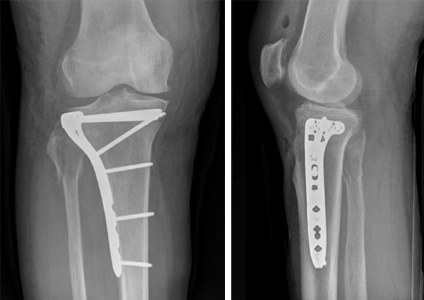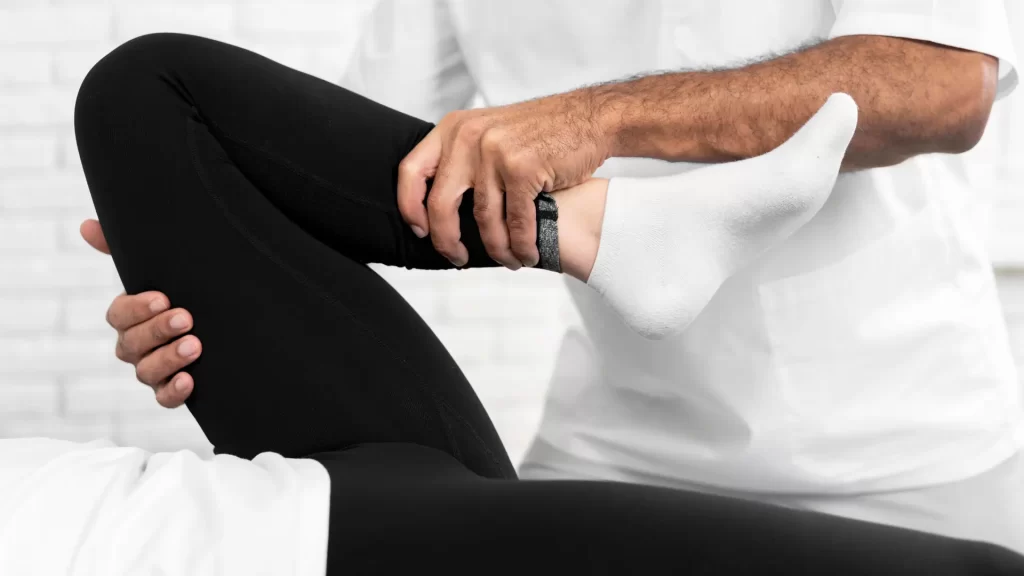The tibial plateau fracture is a serious injury involving the knee joint and usually emanating from high-impact trauma or other bone-weakening conditions. These fractures may vary in degree, from minor fractures or cracks that involve only minimal surface area disruption to more serious breaks that significantly disrupt the stability and function of the knee.
Understanding the nature of this fracture, common causes, and appropriate methods of treatment may provide some patients with a comfortable base and milestones in their journey toward recovery. This is a guide to tibial plateau fractures, their symptoms, treatment options, and recovery expectations, particularly for those planning to seek care in Turkey due to its advanced orthopedic treatments.
What Is Tibial Plateau Fracture?
The tibial plateau refers to the top part of the tibia or shinbone that forms the knee joint. A tibial plateau fracture is a break or crack into this part, usually involving the covering articular cartilage surface of the femur or thigh bone. Fractures in this region may significantly impact one’s ability to walk or even stand with pain, as the tibial plateau bears much of the weight of the body and may affect smooth knee movements.
Depending on the site and severity of the break, these fractures can be classified into six types: from the relatively simple fracture through to the complex multi-fragment injury. They may also include soft-tissue injuries nearby-ligaments, tendons, and menisci-essential to knee function.

How It Happens
These are fractures that take place as a result of a high-energy trauma-for example, a car accident, a fall from considerable height, or sports injuries. These activities exert extreme pressure on the knee, displacing the femur to crush against the tibia, thus causing it to fracture.
These are fractures, apart from high-energy injuries, may be related to low-energy trauma, such as slipping or falling on a hard surface, among elderly patients or patients with osteoporosis. Other disorders, like bone tumor or long-term steroid use, can also weaken the tibia and make it more susceptible to fractures with minimal trauma.
Also vulnerable are athletes, especially those engaging in contact sports such as football, skiing, and basketball, where the knees bear massive strain.
Symptoms
Symptoms of a tibial plateau fracture can vary, depending on the severity of the injury, but common signs include the following:
Severe pain: Pain is often sharp and immediate and centered around the knee and upper shin.
Swelling and bruising: The knee might swell up considerably, and bruising may appear shortly after the injury.
Inability to weight bear through the knee: The vast majority with this fracture would find it hard or impossible to stand or even walk because of intolerable pain.
Deformity: In some instances, misalignment of bones may lead to an appearance of the knee or leg being out of shape.
Limited range of motion: The knee joint becomes stiff and difficult to bend or straighten fully.
Instability: The knee may feel unstable, giving way when attempting to stand or walk.
These symptoms necessitate immediate medical attention, because delayed diagnosis and treatment may result in permanent sequelae, such as arthritis or permanent joint damage.
Treatment in Turkey
Considering all these factors, Turkey has emerged as one of the destinations for orthopedic treatment because of its offering of high-class medical services at competitive prices. The treatment of tibial plateau fractures normally depends on the type and severity of the fracture. It is, however, often designed with the key aim of restoring function to the knee, thereby preventing long-term damage.
Non-Surgical Treatment
Nonoperative management is usually sufficient for minor fractures that are both stable and well-aligned. The following are examples:
Immobilization: This initially involves the use of a knee brace or plaster of Paris to stabilize the leg, thus allowing no movement and allowing the bone to heal.
Physical therapy: A course of physical therapy is begun once the bone has commenced healing to help in restoring muscle strength, flexibility, and range of motion.
Pain Management: Anti-inflammatory or painkiller medications are prescribed to manage possible discomfort during the healing process.

Surgical Treatment
More serious fractures, especially if including displacement or soft-tissue injury, require surgery. Because all Turkish hospitals are technically up to date and use knowledgeable orthopedic surgeons, many patients undergo their treatments in that country.
To name some surgical options:
Open Reduction and Internal Fixation (ORIF): In this procedure, the bones are brought into their normal anatomic position, and metal plates, screws, or rods are used to hold the bones in place to properly heal.
Arthroscopy: When there is damage to the soft tissues of the knee, such as ligaments or cartilage, a minimally invasive arthroscopic surgery may be performed to repair such areas.
Bone grafting: When there is considerable bone loss in the fracture, the operating surgeon will have to do a bone graft to ensure stimulation of healing to stabilize the structure.
Physical therapy after the surgery ensures total recuperation of knee functionality; hence, rehabilitation centers in Turkey focus on personalized recovery plans.
Recovery Phase
Recovery from a tibial plateau fracture will take some time and difficulty, depending on the severity of the injury and the type of treatment involved. Most patients can expect it to take several weeks to months for recovery, while complete return to activity may take up to at least a year or longer.
Recovery Timeline:
Immobilization: Should this be a case of nonsurgical treatment, a brace or cast will be worn for six weeks. Weight-bearing activities are usually restricted.
Postsurgical rehabilitation: Most of the patients stay in the hospital for a couple of days then are further followed up with a supervised rehabilitation program.
Physical therapy: It is rather important to undertake a course of physical therapy in order to regenerate knee strength, flexibility, and range of motion. The duration and intensity of treatment depend upon individual progress made in rehabilitation and upon the complexity of the fracture.
Return to activities as usual: Most patients are able to resume daily activities in 6-9 months; however, high-impact sports and strenuous activities may take longer.
During this phase of recuperation, it is highly essential to follow the medical advice as closely as possible in order to avoid any complications for the very best outcome.
FAQ
Is It Possible to Walk with a Fractured Tibial Plateau?
Generally, a fractured tibial plateau is not recommended to walk on, unless one has sought and obtained a doctor’s advice to the contrary. Doing this might amount to aggravating such a fracture and complicating it further. Generally, weight-bearing is not advisable before such a time when the healing is usually considered to have sufficiently progressed, usually within 6-12 weeks.
How Severe Is a Tibial Plateau Fracture?
Tibial plateau fractures are severe because they may interfere with the knee joint, leading to possible disability in the knee due to arthritis or limited mobility. Treatment and prognosis will depend upon the severity of the fracture and the soft tissue injury present.
Can you bend your knee with a tibial plateau fracture?
There is typically very limited bending of the knee, particularly in the early period following the injury after a tibial plateau fracture. In fact, the knee’s range of motion should be returned to normal through the use of rehabilitation exercises and physical therapy when the bone heals.
Question: Does a tibial plateau fracture require a cast?
Whenever the fracture is less complex and stable, a brace or cast is used to support the leg; the more complex cases require the fixation of plates or screws surgically, and in that case, all depends on the suggestions provided by the surgeon.
Is it safe to sleep without a brace with a tibia plateau fracture?
Patients are usually advised to wear a brace continuously, even while sleeping, during the early stages of their healing process, which keeps the knee safe from further injury and will also avoid jerking motions that might hinder the course of healing. The need for a brace will decrease as the healing of the bone progresses along with improvement in movement.
Will I have to wear a knee brace following a tibial plateau fracture?
A knee brace is often prescribed in the phase of recovery, since it helps to support the joint and limit movement. The length of time that the brace is worn would be determined by the severity of the fracture and by how well and quickly it is healing.
What is the quality of life after a tibial plateau fracture?
Life after a tibial plateau fracture depends a great deal on the severity of the injury and also the effectiveness of the treatment applied. Many patients do quite well and regain full functionality to resume daily activities as usual after proper care and rehabilitation. However, some patients may be left with residual stiffness, arthritis, or limited mobility, especially in cases that are more serious.
Conclusion
A tibial plateau fracture is one of the serious injuries that require timely and proper treatment, ranging from nonsurgical to the latest surgical procedures; recovery will be provided to restore functioning to the knee again. The potential in Turkey, however, assures them that such a procedure is in capable hands.









